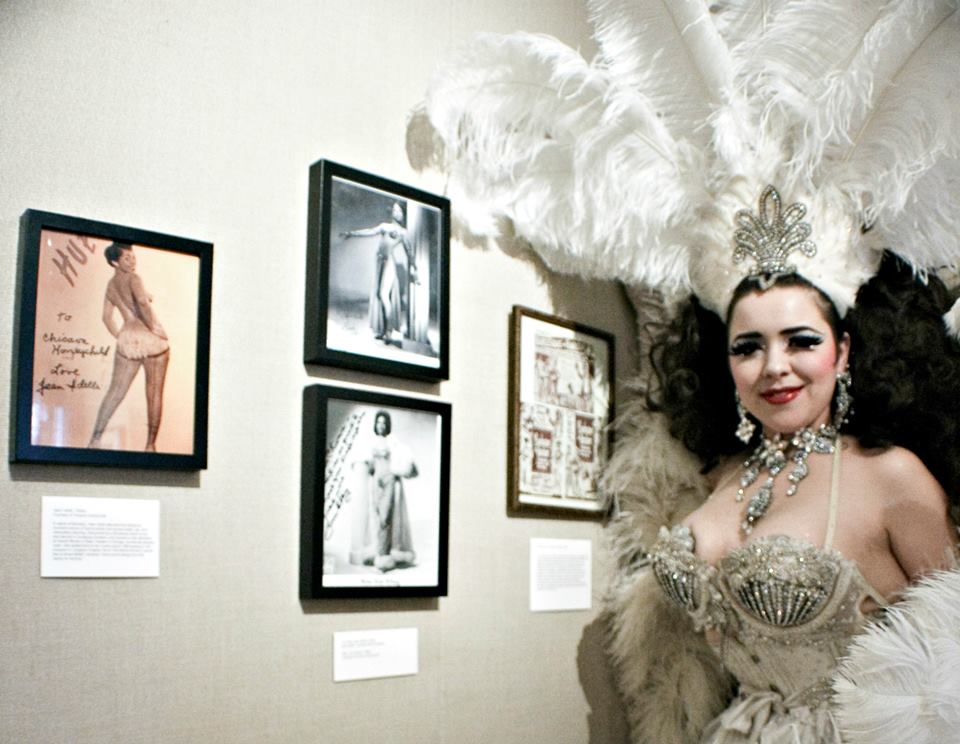Read on to find out more about a fabulous burlesque exhibition in Milwaukee, US, which is open until July 5th, 2015 and includes items contributed by The Burlesque Hall of Fame…
“More on Less: The History of Burlesque From Lydia Thompson to Amber Ray presents the history of burlesque in America — surveying its cultural influence and artistic development from the milestone performances that popularised its early stars, to the legislative and political backlash that undermined them, and ultimately, to the advent of Neo-Burlesque and the rise of a new set of burlesque icons.
“Stars like Gypsy Rose Lee, Sally Rand, Lili St. Cyr, Rose La Rose, Tempest Storm, Jennie Lee, Dixie Evans, Ann Corio, and contemporary performers Dita von Teese and Amber Ray are all on display, represented in photographs, costumes, advertisements, playbills, posters, vintage footage, sheet music, art, and autobiographies. Authentic costumes, both historic and contemporary, are major highlights of the exhibition. Costumes and other materials will also represent the history of men in burlesque, covering the trope of the straight man to the ‘top banana’ comics like Bert Lahr. Works by major artists are also included, demonstrating the appeal of burlesque, its dancers, and its audiences as subjects for modern painters and photographers.”

Featured performer Amber Ray, who has several costumes on display in the exhibition, describes her start in burlesque fifteen years ago:
“It was 2000; it was an amazing time. The internet was being beginning and people were connecting all over the world. I found many others who were doing little shows in their own towns and locked myself into that network. Shortly after I moved to NYC where there were less than 20 of us doing burlesque, and the rest is history. I aimed to carry on a legacy of art and performance that spanned generations and made NYC what it was… a torch bearer.

“The international community started growing and became a network. Today it has become an industry, from shows big and small all over the world to classes, to crafts people, costume designers, graphic designers… artist of all types have assembled to put their spirit into what burlesque has become today.

“In my 15 years in the burlesque world, I have seen thousands of people find their voice, their individual spirits and expression. It’s been done through humour, through political statements, through openness and the spirit to just have fun and/or make something beautiful. The way this has opened up people individually has spread like wildfire though the world.
“I would like to thank Annemarie Sawkins whose interest and investigations sparked this exhibition, the board who approved it, and The Charles Allis Art Museum staff and supporters. I’d like to also thank the entire burlesque community for their efforts, from the ones who layed the groundwork for our history and passed like Dixie Evans and Jennie Lee, as well as the rest of the legends, to the new leaders, new kids and our satellite families of musicians, sideshow, productions and variety! I’d like to thank my family and friends for supporting me and cheering me on as well.”
More on Less: The History of Burlesque in America From Lydia Thompson to Amber Ray
April 10 – July 5, 2015 Charles Allis Art Museum, Milwaukee.




Rachel I don’t want a gold star, a pat on the back or you to baby me. I would appreciate your respect. Curators of color were not reached out to because the curators who made the exhibition were not of color. Chicava was contacted and was involved, lending her 8x10s of various performers. Black women had a whole wall in the historical portion of the exhibit as well as being included in the rest of the exhibit in various places. Please see the email Annemarie sent you and check out the gallery guide and the representation of color in the exhibition documents that she sent. I hope it will be to your satisfaction. If not, I don’t know what to tell you. We all were very conscious about what you are looking for and worked to achieve equality and respect all involved with passion.
I will not oblige your request to hold my criticism Amber Ray. If there is such adequate representation of Performers of Color, why wasn’t it represented in the promotion? Surely there was thirty seconds to review it.
My question to you, as the liason is why weren’t more curators of Color reached out to? What about the representation of neo burlesque performers of color?
You don’t get a gold star for “speaking on race issues”. Furthermore,it’s not up to you to decide for other burlesque enthusiasts of color that they are adequately represented in an exhibition. Your defensive tone is very telling indeed.
Oh and it’s Chicavas pictures of the black legends in the exhibit, so she too was involved Dr.Snapz. Go ahead and ask her. Thanks.
Further more, Dr.Ginger Snapz, Dustin Wax was a part of this exhibit and the history of Butlesque was adequately represented in all its facets. Ultimately I was not the curator and neither were you, so unfortunately you will have to make your own exhibit if you don’t agree that my best and strongest efforts for women of color was heard and heeded. Hollie Mae edited my speech and tailored all the information I gave her, and this is what you got. How about asking questions before being so accusatory? I assure you, It will serve you much better and no one would be able to mistake you as foolish. Feel free to PM me if you want to discus this further, I await your personal action with anticipation.
There was adequate representation of women of color in this exhibit. It’s a shame you couldn’t have seen it. I was very strong with the curator to seek out pictures, history and stories about women of color. I myself spend day after day discussing racial issues and equality because it is a passion of mine to bring these things to light. It’s one of the top priorities in my list. There was not only a gallery wall of women of color but also a couple shelves of pictures and play bills from the forbidden city in san francisco. One wall even pictured a black dancer,( whose name escapes me), dancing live in a milwaukee club in the 50s. Please save your critiques for actually being at the exhibit and experiencing it because what you speak of has no baring, Dr.Snapz. Thank you.
I don’t see adequate representation of Performers of Color in this promo. I’m extremely disappointed to say the least
I understand that this article is short and only a small glimpse of Amber Ray’s exhibit. But it appears that there are only two token women of color: Ms. Jean Idelle and Ms. Toni Elling depicted in this exhibited. In her research with the Burlesque Hall of Fame did Amber Ray consult the Burlesque in Color exibit which was curated by Dustin and many women of color (myself included) a few years ago. In addition, there are numerous scholars of the integral role people of color have played in burlesque myself (Dr. Ginger Snapz), Tangerine Jones, Chicava Honeychile, and International Black Burlesque Company to name a few.
I realize it is difficult to see the full scope of a exibit from a short article and a few pictures. I’m just question whether the fundamental historical role of performers of color has been, once again sidelined, in favor of a primarily whitewashed narrative of burlesque.
Best,
Dr. Snapz